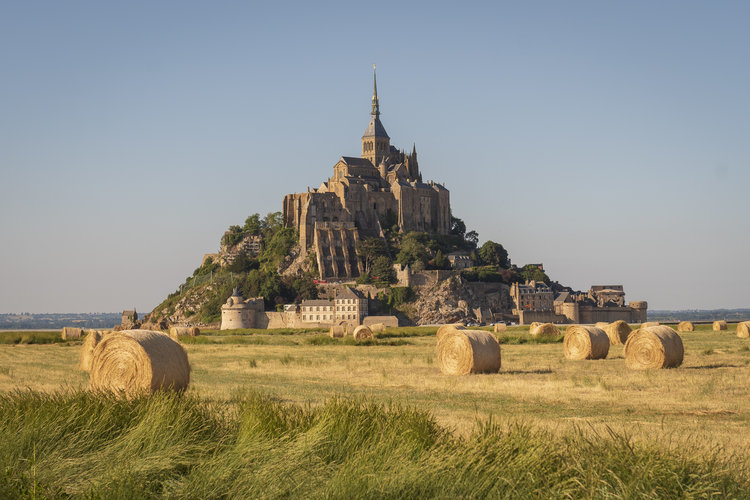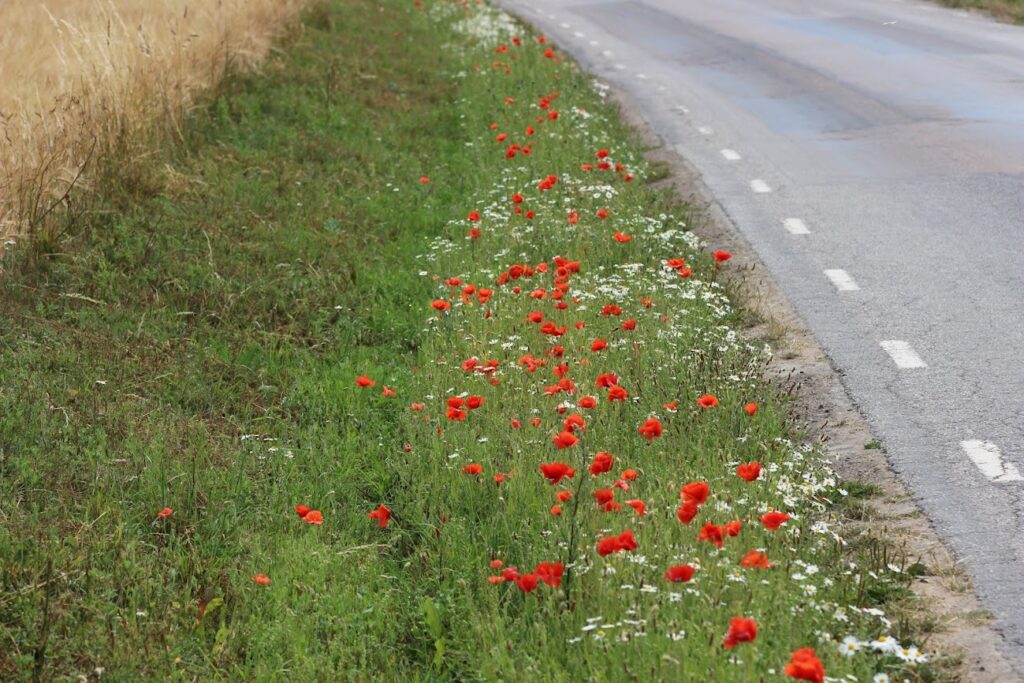Life has been reduced to three suburbs over the past couple of months, and the winter glooms have given me no incentive to expand my horizons. But with a couple of free days up my sleeve to sort through piles of notes and papers and the general shemozzle that is my office, I revisited some old travel diaries. Procrastination? Yes indeed!
So, this morning I found myself back in France, cycling furiously uphill to keep warm, heading for Mont St Michel. In case you are not familiar with the image, this ancient abbey is perched on a granite outcrop on a vast stretch of tidal bay on the coast of Normandy. It was built in the 11th century by Italian architect, William of Volpiano, who designed the Romanesque church within the abbey walls at the summit of the hill, supported by a plethora of underground crypts and chapels. The original natural causeway to the island was only accessible at low tide, which made it relatively easy to defend. As the tide came in, would-be attackers would be stranded or drowned. A raised causeway built in the late 19th century allowed tourists easier access, but caused the bay to silt up, changing the landscape quite significantly.
Since we camped in the poppy-spotted meadows on the mainland way back in 1991, there have been a lot of positive changes. A dam has been built on the River Couesnon which emerges into the bay opposite the island, to reduce the silt. The car park has been moved further away from the island, and a bridge has replaced the causeway, which allows the sea to flow around the island and wash away the mud.
Back in the summer of 1991, in the height of hay fever season, we were on mountain bikes. Between fits of sneezing, a distinct lack of signposting and a gusting wind determined to toss us into the path of passing trucks, the final lap to Mont Saint Michel was less than pleasant. However, the occasional glimpse of our destination across marshes or wheat fields was energizing. Against all odds, we eventually reached our campsite among the poppies and made a short foray along the causeway before dinner. At that time of day, we had the place almost to ourselves, and could wander unhindered through the cobbled lanes and up to the abbey. By mid-morning, the alleys were awash with coach tourists and tacky souvenir stalls, undeterred by a regular baptism from the heavy grey clouds above our heads. It was a damp and chilly day, but the climb to the abbey was worth it for the views across the bay to Tombelaine, another rocky outcrop a few kilometres north of Mont Saint Michel. (Apparently you can walk across the sand at low tide, but you wouldn’t want to linger.) Inside the Abbey, the maze of vaulted halls and stained glass windows was stunning, but there can’t have been much joy in the draughty place for the monks during winter.
Eventually we found our way back down the hill to a doll-sized restaurant tucked against a wall, where we shared an enormous, light fluffy omelette – a local specialty – and a bottle of Muscadet, leaning back, sated to admire this tiny town. Narrow, mediaeval stone houses, squished together and balancing precariously, are decorated with jaunty wooden signs, the steep roofs topped in wooden or lead tiles, small gardens gripping grimly to the granite. These days, the island is shared by only a few locals and a handful of nuns and monks. Tourism is the main source of income, bringing in about $63 million and three million tourists a year, eager to inspect the august Abbey looming protectively above the town.
The next morning, we packed up the tent and set off through meandering lanes, the verges thick with a veritable rainbow of wildflowers: white, fluffy cow parsley, wild foxgloves, yellow dandelions, miniature white daisies, pink campions and blue love-in-the-mist. Summery scents hung in the air, birds twittered from the depths of the hedgerows, noisy but invisible. We passed farmhouses with potted geraniums on doorsteps and balconies, doorways strung with multi-coloured roses, the ubiquitous dogs barking histrionically on the end of their chains. We stopped for morning tea at a patisserie in La Croix-Avranchin, the only persuasion I needed to get over the more strenuous hills.
There were not many smiles from the passers-by – perhaps they were discouraged by the fierce glare of Graham Gorilla, a grumpy stuffed toy I had bought on the ferry and sat in the basket on the front of my bike. He made me laugh with his surly sneer, but apparently the French found him less than amusing. I did, however, get a round of applause from a friendly group of workmen as I struggled to the top of a hefty slope into Baille. Here we had a picnic in a glade we shared with mossy tombstones, on the edge of a beech wood, chockablock with bracken, beechnuts and foxgloves.
Our next campsite, in Saint Aubin, was beside the village pond and below some old castle ruins, six stone towers rising high above the trees. We clambered across overgrown ramparts to see huge fireplaces still intact some thirty feet above the ground, clinging to the stone walls like hanging baskets. No fires here tonight, though. The countryside was largely rural: green fields full of calves and cows, lambs and sheep; pretty white farmhouses and old barns…
We were heading for the Loire Valley, where my heart was set on visiting every chateau we came across. A week in, and we had completed almost 350 km to Ancenis, once a port, now known as the key to Brittany. The sun had finally emerged from behind the dark grey clouds that had followed us all the way through Normandy and Brittany to the Loire, and the sky was deep blue. It wasn’t perhaps the prettiest town in the neighbourhood, but the weather was perfect for a mediaeval festival, which kept us in town for an extra day. The pageantry was superb: knights on horseback, royalty and peasants, musicians – it seemed as if the whole town had found costumes for the occasion. Even the shopkeepers had gone to the trouble of dressing up their shops and themselves. The streets were strewn with straw and there was a wine stall on every corner. With terracotta roof tiles, a mediaeval castle, and an ancient bridge, Ancenis is one of the oldest towns in the region, settled as early as 984 AD, and we felt as if we had gone back in time as the festival got underway. A final picnic lunch by the river with a soft, creamy brie and a fresh, crusty baguette, and then onwards to the land of fairy tale castles…



